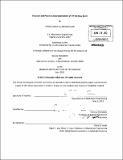Fracture and plasticity characterization of DH-36 Navy steel
Author(s)
MacLean, Christopher Glenn
DownloadFull printable version (12.31Mb)
Other Contributors
Massachusetts Institute of Technology. Dept. of Mechanical Engineering.
Advisor
Tomasz Wierzbicki.
Terms of use
Metadata
Show full item recordAbstract
Multi-layered plates consisting of DH-36 steel coated by a thick layer of polyurea, for increased blast and impact protection, are of increasing importance to the Department of Defense. A hybrid approach of experiments and simulation was performed to characterize fracture and plasticity of DH-36 Navy steel, which is the first step in creating an accurate model of the composite material. The performance limit to this material during an impact is ductile fracture. The prediction follows that the onset of fracture occurs when a certain critical value of plastic strain is reached. This value is highly dependent on the state of stress. Seven different types of tests were performed, including tensile tests on dog-bone and notched specimens and punch indentation tests on circular blanks. Also, tensile and shear tests were performed on butterfly specimens using the dual actuator loading frame. Fracture surface strains were measured using digital image correlation. Local fracture strains were obtained by using an inverse engineering method of matching measured displacement to fracture with computer simulations. The results are used to calibrate the Modified Mohr Coulomb fracture model which is expressed by the stress state invariants of Lode angle and triaxiality.
Description
Thesis (Nav. E. and S.M.)--Massachusetts Institute of Technology, Dept. of Mechanical Engineering, 2012. Cataloged from PDF version of thesis. Includes bibliographical references (p. 44-47).
Date issued
2012Department
Massachusetts Institute of Technology. Department of Mechanical EngineeringPublisher
Massachusetts Institute of Technology
Keywords
Mechanical Engineering.